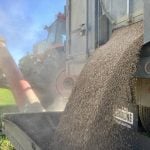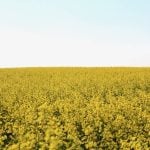Over the last decade, root rots have become widespread on the Canadian Prairies and are now a fact of life for many pulse growers. Grow the same crop long enough, experts say, and it’s almost certain root rots will show up in your fields.
And it’s no small problem for farmers in Western Canada. Some reports have suggested root rots cost the industry as much as $1.5 billion per year in diminished exports and domestic sales.
The good news is help could soon be on the way.
Read Also

Claas brings 1000 Series SP forage harvesters to Canada
In mid-August, Claas unveiled its new line of Jaguar forage harvesters at an event in Visalia, California, deep in the heart of that state’s dairy region.
Sabine Banniza is a professor of plant pathology at the Crop Development Centre at the University of Saskatchewan, where she has been working on pulse crop diseases for more than 20 years. She spoke at Saskatchewan Agronomy Research Update 2022 in Saskatoon, Sask., last December, where she delivered an update on root rots in pulses.
Root rots are hardly a new problem. Banniza said it’s probable one of the main culprits, Aphanomyces euteiches, has always been in the soils of Western Canada. However, with more farmers choosing to grow peas and lentils, A. euteiches and other root rot pathogens that cause disease have also increased in the soil.
Scientists collaborate
The problem also became an issue in chickpea fields, with surveys in 2019 and 2020 showing serious root rot problems in some areas, which were coinciding with other undetermined causes of symptoms, most notably in parts of Saskatchewan including Gravelbourg, Assiniboia and Coronach. Banniza said that inspired her and other scientists to put their heads together to figure out what was going on and to find possible solutions to the problem.
The first step was to test the various types of root rot pathogens, including Aphanomyces euteiches and Fusarium sp., to determine which ones were causing the issues. Banniza said this was necessary in order to start breeding for resistance because breeding is carried out on a pathogen-by-pathogen basis rather than all of the pathogens at once.
The four most commonly identified strains of root rot pathogens in peas, lentils and chickpeas were Fusarium avenaceum, Fusarium redolence, Fusarium solani and Fusarium oxysporum. A. euteiches was also found in peas and lentils. However, it was another pathogen, Fusarium culmorum, that proved to be particularly virulent on chickpea in repeated tests and caused high levels of the disease, as did F. avenaceum.

Screenings of wild lentil species showed a notable resistance to both A. euteiches and F. avenaceum in a close relative of lentil, Lens orientalis. Banniza said that was a welcome development because it’s possible to find one or two accessions that have good resistance to both pathogens (an accession is a distinct, uniquely identifiable sample of seeds representing a cultivar, breeding line or population maintained in storage for conservation and use, according to FAO).
“We know from peas that aphanomyces resistance tends to be a quantitative trait. That means it’s not just one or two genes that are involved in resistance, but there are many genes, and that makes breeding much more difficult. What we have been trying to do is develop molecular markers to assist with that, and we are closer now to having those tools in lentil as well,” she said.
“What we are hoping is that with this knowledge, we can complement traditional breeding through pathogenicity (the ability to produce disease) testing with these molecular markers, which should help us to move faster in terms of moving resistance into adapted varieties. That is what we were able to do in pea already.”
Banniza also highlighted the results of a study conducted by Syama Chatterton of Agriculture and Agri-Food Canada’s (AAFC) research centre in Lethbridge, Alta. The study focused on cover or rotational crops (caliente mustard, faba bean, Sinapsis alba and oats) used for green manure and the antimicrobial compounds they release into the soil that have the potential to suppress certain microbes including pathogens.
Chatterton’s study results did not find any significant differences among the rotation or cover crop treatments. However, the test site in Lacombe, Alta. —which received more rainfall than test sites in Saskatoon or Lethbridge — did see a boost in yield.
The effect of tillage on the release of antimicrobial compounds in soil was a secondary focus of Chatterton’s study. Banniza said while disease severity appeared lower, the study’s results indicated there was no statistically significant differences between tilled and non-tilled soil.

Alternative solutions
Another research project led by Michelle Hubbard of AAFC’s research centre in Swift Current, Sask., recently examined the effect of liming on aphanomyces root rot.
Four different liming products were studied including hydrated lime, Zero Grind limestone, spent lime and gypsum. All of the products were applied manually with the application timing either in the spring or fall of the year prior to pea production (2021) and again in the spring of the pea production year (2022).
Banniza said none of the products appeared to have any effect on the disease or disease severity. She said those results could reflect the need to study the products and their effects on disease for a longer period. Also, the region experienced some challenging weather conditions during the study.
As part of a followup study, Hubbard also looked at the effects of several natural products on aphanomyces root rot. None of the products appeared to control the disease.
Banniza explained while there is no “silver bullet” solution for root rots in pulses, she is hopeful scientists and plant breeders will develop solutions to the problem in the not-too-distant future.
In the meantime, she said her best advice for growers is to continue implementing long and diverse crop rotations if they are concerned about high levels of root rot pathogens in their fields.
“Remember, seed treatments are only effective for maybe three to four weeks, so all they do is get the seedlings from these seeds out of the soil,” Banniza added. “But these root rot pathogens can infect plants later during the growing season as well.”
Banniza also urged farmers to take part in provincial disease surveys as they play a critical role in determining what research must be done and which diseases are important for breeding, like root rots.
“The better we understand what is happening in the fields, the sooner we can respond to that and start doing the research.”

















